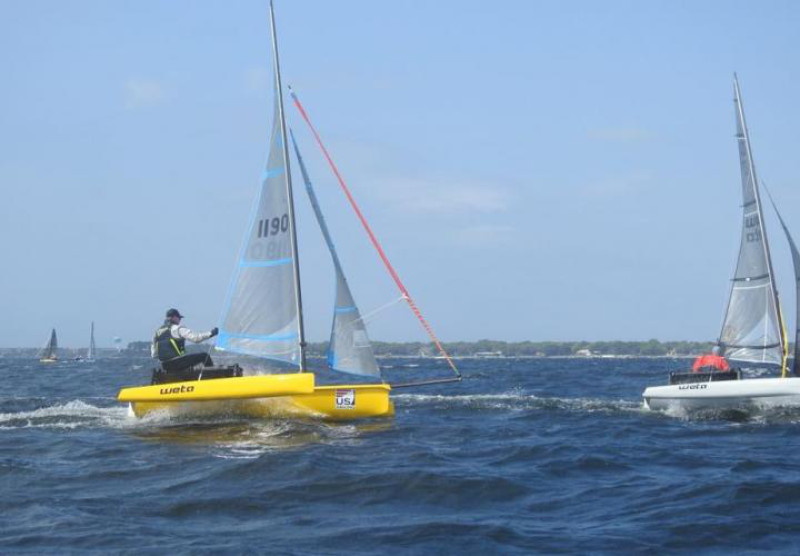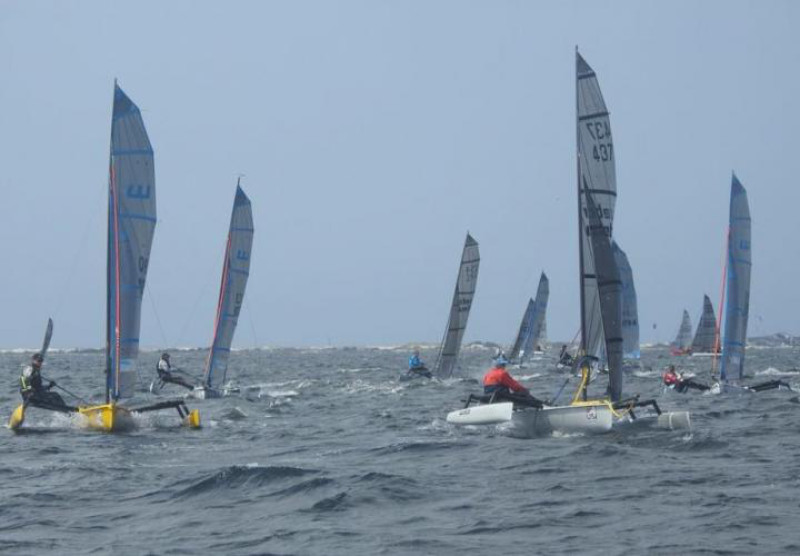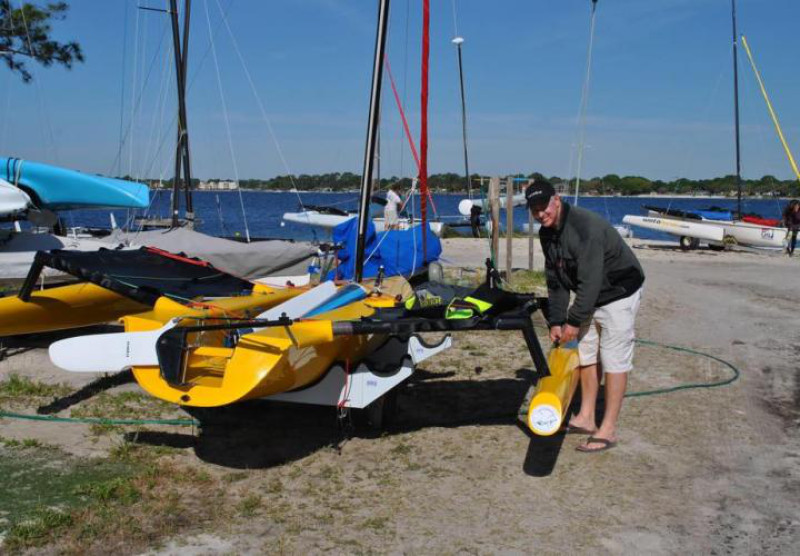
May 01st, 2018
Weta Marine, manufacturer of the successful Weta Trimaran, provided me with the opportunity to try out their new and improved Weta Trimaran. The event? 2018 US Multihull Championships at Fort Walton Yacht Club, FL.
For the racer, several questions needed answering: Was the savings in weight from the new foam core hull construction a regatta changer? How about gains with the new sails? What about one design integrity? Would older sails, and older boats, be able to compete with the new? We would soon find out.
For the recreational sailor, advantages to the new boats were obvious. They are lighter, thus easier to maneuver on the land dolly. The stronger construction means longer lasting boats. Plus, they now came in a plethora of colors and color combinations.
After winning Nationals at the heavy air Columbia River Gorge, Roger had brought me here as a reward and tester of the new boats. However, this was a light to moderate air venue, and I had told Roger I was retired. Perhaps it was Roger’s plan, to have the big guy tank (my nickname is Donuts); the one design integrity would be clearly stamped by my poor results.
Mike Krantz, a previous Weta National Champion, was there to prove the boats fast just in case, and Randy Smyth, another two-time Weta National and Olympic Silver medalist (2), would prove that old boats could compete just as well as the new ones. My expectations were low, but I couldn’t resist trying out the new and improved lighter Weta. Besides, getting together with old friends at one of my favorite sailing venues, FWYC, I couldn’t lose.
First Impressions
The initial sight of these new boats as we pulled into Fort Walton Yacht Club was a real eye opener. Sitting there in the warm, Florida sun were eight new boats, as smart looking and pretty as a new Ferrari. Also looking pretty were the fellows unloading them: Roger Kitchen, Weta co-designer from New Zealand, and Richard Hitchcock, Weta Florida Ambassador.
The “New Weta,” or as I call it, Weta version 3.0, now comes in a plethora of colors, some with white decks for wicked style and racetrack points. Krantz would get an aqua/white combo, I would get cadmium yellow, and Dave Berntsen white. But the best-looking boat was candy apple red with white deck, the fleet Ferrari. Sweet as! (I believe this is a Kiwi saying) Spot on! (That works).
What was different about this new Weta? Was it stiffer? Lighter? We had no scales to verify, and I wasn’t about to hammer on the hulls. Racing or not, new boats are nice to look at on land or water. The new Wetas look like salt water taffy, or glazed donuts coming hot down the conveyor belt, depending on your hunger level. I was hungry to sail one.
Was the new Weta easier to launch, move around on land? Yes. But uphill, both ways, in the sand? It’s all about the dolly wheels on this one. The new boats ship with a bit bigger wheels than the old, so even on my own, I could wrangle it with ease.
My SF Bay Area bros, legend “Davo” Dave Berntsen and newbie David Bacci arrived early to knock rust and taste new Weta. With conditions pina colada perfect for Weta sailing, 15-18 knots, the new boats felt lively. The chop was nothing like what we typically plow, yet the boat seemed stiffer. They just felt great stock right out of the box. Was it my imagination or was the boat quieter? I’m 60, so it might be a loss of hearing, but it certainly seems like the foam core dampens the chop inducing vibration.
Trunkin Nailed It!
The biggest difference I noticed was in the daggerboard trunk. Previous versions of the Weta have had variances in the width of the trunk and blades. If it’s not a snug fit, you needed to make it one, which took a lot of work. I’ve discovered through my boat and borrowing lots of Wetas, that the two key factors in upwind speed at least, are how new are your sails, and how tight your trunk. Loose daggers get outpointed to weather. Too tight, and it’s a struggle to raise and lower the board. But with the new boats? Goldylocks. The board raises up and down with ease – no restraining shock cord necessary – and seems to be a tight fit.
This improvement came at a price to the manufacturer, as they couldn’t just buy a small lot of the secret sauce that pads the board snugly. Roger, when asked what exactly this stuff was made of, replied, “a German windshield material,” though I think he means side window padding. Kiwis have different names for everything, just so you don’t confuse them with Aussies (who actually build the boats at XSP in some place called Batman, Indonesia).
Sails, the X Factor
Before the new boats were launched, the sails were modified just before the World Master Games in NZ by North Sails. Wow, these sails were something to look at. Talk about laminar flow. Gone were the odd wrinkles and leech flutter of the old sails.
Historically, for recreational sailors, the older Gaastra mylar sails have held their shape for many years. It’s only the punishing racer’s complaints that prompted a change. Roger states that, “Up until recently the sails were pattern cut. The new blue trimmed digital cut sails are using a slightly lighter North manufactured Mylar fabric. We have changed the fabric panel orientation slightly to give more support maintaining the sail shape. The new sail was the result of averaging out 6 sails selected from Gaastra and Norths over the last 10 years to maintain OD.”
There is even a newer “fathead” or squaretop version of the main being manufactured, which could become class legal in 2019. “The bigger main is easier to control in high winds as well,” claims Bob Hodges, new US Weta Class President.
Mods
There were some modifications made to the boats that included 2:1 jibsheets, fixed bridle traveler, and outboard kite placement speed rings. I was reluctant to use any for the regatta, but will probably do so going forward. All three make the boat easier to sail, so it’s not all about the racing on these improvements. That said, I’ve lived a happy Weta life six years without them.
The Racing
In the championship regatta, I did feel fast, even for a donut in light to moderate winds, and would attribute it more to the sails than the weight of the boat, though weight does matter. Even trimming the boat down twenty pounds will not make a difference if you gain thirty over the Winter and head for the wrong start line! The sails trimmed right provided the power to roll the heavy donuts forward. I made enough mistakes to fill a season of sailing, and still finished fourth. So yes, fast boat, really fast sails. I felt the power.
The Weta has extended the life of many sailors who still want the thrill of multihull sailing without the constant pitch poling (though others have, I’ve never flipped it). It’s easy to raise the mast, and the boom – there is no boom to go boom. For those high on the concussion count, it’s something to seriously consider. High school sailor Cam Farrah proved that it’s also a fun, thrilling boat to sail for youngsters. We hope to see more of the tadpoles out there in the future.
In Conclusion
My take on the deal is that you can have an old boat (boat #18 was in the fleet and still competitive) but you have to keep your sails fresh, and the new sails are indeed better. Bob Hodges proved that with the heavier Weta 2.0 version (seamless amas), and new North Sails, you were still fast. Randy, he’s an Olympic pro sailor, and these were his home waters. He can win with bed sheets on a garbage can. But duly noted by all, after day 1 and getting rolled by top guys including the donut downwind, he changed his kite to a newer one.
The previous version Gaastra sails have a slightly fuller cut and leech, so they are still competitive in up to 15, but the new Norths are imho far and away faster in breeze. I faired well even in the light air races at 250 pounds, when I kept them in clear air, pointed in the right direction. It’s one of those odd requirements for racing success.
I was not alone in my assessment. On our Yahoo Group, Berntsen posted: “The new boats are true one design with same layout as all other Wetas. The major improvements in the new boats is build quality;
- blades are very clean and good foils
- foam core construction make boats lighter but all within Weta one design spec
- improvements on trampoline reinforcement
- The best improvement is the new North Sails (Grey with blue trim). Much stronger material, better sail shape and fast. If anyone wants to make an upgrade to their older boat - get a new set of sails! You'll know what I mean when you see/try them.”
The results amongst the seven new boats chartered or purchased for this regatta were mixed across the board. As you can see, old guys in old boats did just as well as young kids in old boats and old kids in new boats.
Final Results (Top 10 of 34; 10 races, 1 discard)
1. 437, Randy Smyth[WETA SINGLE], 2-3-3-3-1-4-1-[5]-2-1- ; 20
2. 1193, Mike Krantz[WETA SINGLE], 1-2-1-4-[20]-1-7-2-1-2- ; 21
3. 1003, Robert Hodges[WETA SINGLE], 3-4-2-5-4-[14]-2-4-3-10- ; 37
4. 1190, Jonathan Weston[WETA SINGLE], 7-5-4-2-2-[10]-9-3-5-4- ; 41
5. 254, Keith Rice[WETA SINGLE], 5-6-7-6-3-2-6-[8]-6-3- ; 44
6. 1199, David Berntsen[WETA SINGLE], 10-1-5-1-12-21-[23]-1-4-9- ; 64
7. 622, Carey Jones[WETA SINGLE], 4-[15]-10-12-13-7-3-9-10-7- ; 75
8. 362, Richard Stephens[WETA SINGLE], 8-12-6-10-[18]-3-8-14-14-6- ; 81
9. 1197, David Bacci[WETA SINGLE], 9-10-8-7-24-13-[26]-11-7-5- ; 94
10. 007, Cam Farrah[WETA SINGLE], 14-19-[20]-16-7-11.5/TIE-4-10-8-8- ; 97.5
Yellow: New Boats. Blue: Weta 2.0, New North Sails
In the doubled-up division (crew on board), the Taylor’s won on a new boat. Stephanie Taylor says, “I absolutely LOVE our new custom color Weta! As the Kiwi’s say, “Sweet As”. The new daggerboard fits the trunk like a glove. It looks like a Weta, it sails like a Weta. Let’s keep growing the class!”
We did not get a chance to put the boat through high wind paces, as racing was canceled for the final big breeze showdown (due to a silly tornado – sheet in, hike harder!) I will honestly have a hard time racing again with the old sails in big breeze. It’s not that big of an investment, and once I get my piggy full, I’ll sport that new boat as well, for the smooth operating dagger trunk alone (okay, it’s the colors, which I believe cost little piggy extra). And for the recreational sailor? As the age old saying goes, “It’s better to look good than to be good.”
By Jonathan Weston

